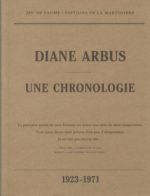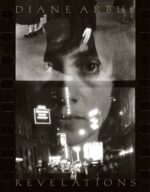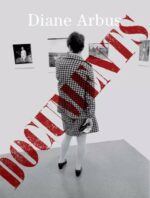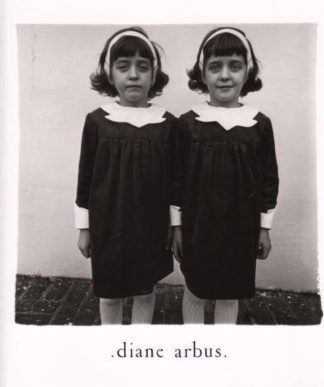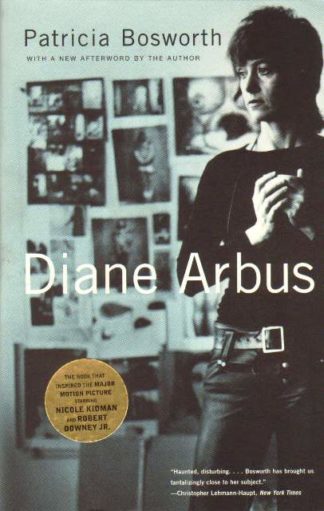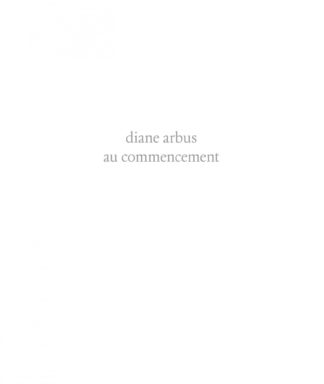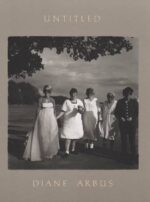En mai 1971, Artforum, bastion du modernisme tardif, présente pour la première fois le travail d’un photographe. Sur sa couverture et sur six pages, il publiait des sélections du portfolio de Diane Arbus, Une boîte de dix photographies. Selon les mots du rédacteur en chef du magazine et jusque là sceptique en matière de photographie, Philip Leider, “Le portfolio a tout changé… on ne pouvait plus nier le statut [de la photographie] en tant qu’art.” Au moment de la mort d’Arbus, deux mois plus tard, seuls quatre exemplaires de l’édition prévue de cinquante avaient été vendus. Deux avaient été achetés à Arbus par Richard Avedon (le premier pour lui-même, le second en cadeau pour son ami Mike Nichols) ; un autre a été acheté par Jasper Johns; et un quatrième par Bea Feitler, directrice artistique au Harper’s Bazaar.Diane Arbus a signé les estampes dans les quatre ensembles ; chaque impression était accompagnée d’une feuille intercalaire en vélin portant une légende étendue. Pour Feitler, Arbus a ajouté une onzième photographie, Une femme avec son bébé singe, N.J. 1971.
Acquis par le Smithsonian American Art Museum, Washington, DC, en 1986 – et le seul des quatre complété et vendu par Diane Arbus qui est détenu par le public – ce portefeuille fait l’objet d’une exposition présentée au musée d’avril à septembre 2018. Ce livre exceptionnel reproduit la nature de l’objet originel et désormais légendaire de Diane Arbus. Le conservateur du Smithsonian, John P. Jacob, qui a déniché une mine de nouvelles informations lors de la préparation du livre et de l’exposition, tisse une histoire fascinante sur la création, la production et les répercussions continues de cette œuvre phare ; texte de John P. Jacob.
Publié par Aperture en association avec le Smithsonian American Art Museum, Washington, D.C.
In May 1971, Artforum, bastion of late modernism, featured the work of a photographer for the very first time. On its cover and in a six-page spread, it published selections from Diane Arbus’s portfolio, A box of ten photographs. In the words of the magazine’s editor and photography skeptic, Philip Leider, “The portfolio changed everything . . . One could no longer deny [photography’s] status as art.” At the time of Arbus’s death, two months later, only four of the intended edition of fifty had been sold. Two had been purchased from Arbus by Richard Avedon (the first for himself, the second as a gift for his friend Mike Nichols); another was purchased by Jasper Johns; and a fourth by Bea Feitler, art director at Harper’s Bazaar. Arbus signed the prints in all four sets; each print was accompanied by an interleaving vellum slip-sheet inscribed with an extended caption. For Feitler, Arbus added an eleventh photograph, A woman with her baby monkey, N.J. 1971.
Acquired by the Smithsonian American Art Museum, Washington, DC, in 1986—and the only one of the four completed and sold by Arbus that is publicly held—that portfolio is the subject of an exhibition on view at the museum from April through September 2018. This exceptional book replicates the nature of Diane Arbus’s original and now legendary object. Smithsonian curator John P. Jacob, who has unearthed a trove of new information in preparing the book and exhibition, weaves a fascinating tale of the creation, production, and continuing repercussions of this seminal work.
Published by Aperture in association with the Smithsonian American Art Museum, Washington, D.C.



